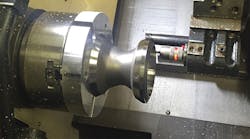High-Tech Materials Have Forger Exploring 3DP Space
Additive manufacturing is driving the imaginations of material scientists in a way reminiscent of past technological phase-shifts, like the growth of computer science in the 1980s or astrophysics in the 1950s. In particular, the latter science seems to be contributing something to the excitement surrounding 3D printing at Metal Technology Inc., a forger in Albany, OR.
MTI is a specialty manufacturer that uses multiple processes (deep-drawing, metal spin forming, machining and EDM) to produce highly engineered parts in critical materials, including tantalum, niobium, zirconium, titanium, tungsten, Inconel, and molybdenum.
Sparking MTI’s interest in AM/3DP is the considerable scale of its activity with primary manufacturers in the space “space”, such as Aerojet Rocketdyne, ATK, Boeing, Honeywell, Lockheed Martin, Moog, Orbital Sciences, Pratt & Whitney, Sierra Nevada Corp., United Launch Alliance, UTC Aerospace, and others.
MTI has produced forgings for NASA’s Orion capsule, which is expected to be carried into space on the new Space Launch System.
NASA is actively integrating AM processes into its engineering and design work, because additive processes make it possible to produce low volumes of highly engineered parts, using high-tech materials. Propulsion engineers and other NASA scientists are using such processes to integrate new features to existing component designs, or joining individual parts using additive manufacturing methods to improve functionality of current designs.
In addition to its forging and other capabilities, MTI’s process technologies include direct metal laser sintering (DMLS). DMLS uses laser power to melt powdered alloys in a bed, according to a pattern defined a CAD program. Last fall MTI started a collaborative manufacturing project with NASA’s Johnson Space Center, using the 3DP process to produce a rocket chamber and a nozzle for an unnamed space program.
Read More



